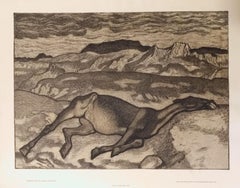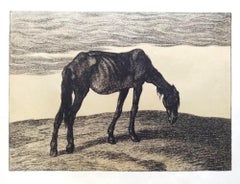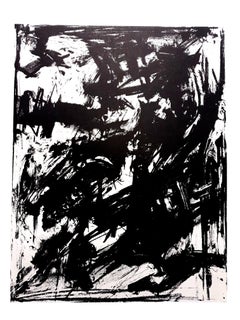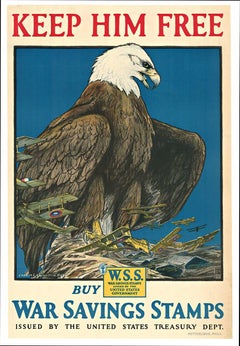Ferdinand Andri Art
to
2
Overall Width
to
Overall Height
to
2
2
2
2
2
2
1
1
2
2
10,138
2,779
1,375
1,368
1
Artist: Ferdinand Andri
Aus Albanien
By Ferdinand Andri
Located in Roma, IT
Aus Albanien ("From Albania") is an original artwork realized by Ferdinand Andri in 1916. Lithograph on yellow plate. Printed by k. k. Hof- und Staatsdruckerei Wien / Albert Berger...
Category
1910s Modern Ferdinand Andri Art
Materials
Lithograph
Ausgedient - Lithograph by Ferdinand Andri - 1917
By Ferdinand Andri
Located in Roma, IT
Ausgedient (“Obsolete”) is an original artwork realized by Ferdinand Andri in 1917. Lithograph in black over yellow plate on paper. Published in 1917 as part of a Jahresmappe (Annual...
Category
1910s Modern Ferdinand Andri Art
Materials
Lithograph
Related Items
Emilio Vedova - Original Lithograph
By Emilio Vedova
Located in Collonge Bellerive, Geneve, CH
Emilio Vedova - Original Lithograph
Abstraction
1961
From the art revue XXe Siecle
Dimensions: 32 x 24
Edition: G. di San Lazzaro.
Unsigned and unumbered as issued
Category
1960s Modern Ferdinand Andri Art
Materials
Lithograph
Original "Keep Him Free, Buy War Savings Stamps" excellent vintage WW1 poster
Located in Spokane, WA
Original WW1 US propaganda poster designed by Charles Livingston Bull (1874-1932) and entitled “Keep Him Free Buy War Savings Stamps”. This poster was issued to promote the US Treasu...
Category
1910s American Modern Ferdinand Andri Art
Materials
Lithograph
$1,198
H 30 in W 20.25 in D 0.05 in
Mary Chenoweth Abstract Birds in Flight Vintage Mid-Century Modern Lithograph
Located in Denver, CO
This vintage original lithograph by celebrated American modernist Mary Chenoweth (1918–1999) presents a dynamic abstract interpretation of birds in flight. Chenoweth’s innovative pri...
Category
1970s American Modern Ferdinand Andri Art
Materials
Lithograph
$2,450
H 34.25 in W 27.25 in D 1.5 in
Horses in Moonlight, Folk Art Equestrian Lithograph by Lebadang
By Hoi Lebadang
Located in Long Island City, NY
Artist: Lebadang, Vietnamese (1922 - 2015)
Title: Horses in Moonlight
Year: circa 1975
Medium: Lithograph, signed in pencil
Edition: Epreuve d'Artiste
Size: 25.25 x 19.5 in. (64.14 x...
Category
1970s Modern Ferdinand Andri Art
Materials
Lithograph
$600
H 25.25 in W 19.5 in
Original "The Ships Are Coming" vintage American poster with an Eagle.
By James Henry Daugherty
Located in Spokane, WA
Original: THE SHIPS ARE COMING vintage poster. Artist: James H. Daugherty (1889-1974)
Publisher: U.S. Shipping Board, Emergency Fleet Corporation, Publication Section, Philadelphia, 1917.
Poster showing a giant eagle...
Category
1910s American Modern Ferdinand Andri Art
Materials
Lithograph
James Henry DaughertyOriginal "The Ships Are Coming" vintage American poster with an Eagle., 1917-18
$1,663 Sale Price
20% Off
H 30 in W 20 in D 0.05 in
“Europa and the Bull”
By Alvar Sunol Munoz-Ramos
Located in San Francisco, CA
You have to hand it to the bull. Not just taking Europa with his unassailable power (he is Zeus in disguise, after all) he brings along a retinue for his seduction of the beautiful P...
Category
1980s Modern Ferdinand Andri Art
Materials
Paper, Lithograph
Origiinal FRANCE, Paese dei Casstelli, vintage French travel poster on linen
By Jean Picart Le Doux
Located in Spokane, WA
Original 1950 “France, Paese dei Castelli” Vintage Poster Artist Jean Picart Le Doux Linen-Backed French Castles Travel Art Rare Mid-Century Collectible
Add a touch of French el...
Category
1950s American Modern Ferdinand Andri Art
Materials
Lithograph
$975
H 39.5 in W 24.5 in D 0.3 in
Jon Corbino, Montana Earthquake, 1936, lithograph
By Jon Corbino
Located in New York, NY
Works by Jon Corbino (1905-1964) feature drama. Here he's showing us the chaos produced by a major earthquake in rural Montana in 1936 -- an actual historical event.
The horses (ear...
Category
1930s American Modern Ferdinand Andri Art
Materials
Lithograph
Original 1945 Paris (France) vintage travel poster travel by train
By Paul Colin
Located in Spokane, WA
Original PARIS linen-backed 1946 vintage travel poster, preservation linen-backed and ready to frame. Very good condition, Grade A-
Original 1946 Paul Colin Paris Vintage Poster ...
Category
1940s American Modern Ferdinand Andri Art
Materials
Lithograph
$1,200
H 39.5 in W 24.5 in D 0.3 in
Original "Wonderful Copenhagen" vintage travel poster
Located in Spokane, WA
Original vintage poster: WONDERFUL COPENHAGEN created by the artist Viggo Vagnby. This antique poster is archival linen-backed, in excellent condition, and ready to frame. No da...
Category
1950s American Modern Ferdinand Andri Art
Materials
Lithograph
$1,375
H 39 in W 24.5 in D 0.05 in
Chuzo Tamotzu Litho, Southwestern Landscape with Donkeys & Mission
Located in New York, NY
Chuzo Tamotzu (1891-1975)
Untitled (Southwestern Scene), c. 1950
Lithograph
Sight: 12 1/2 x 16 in.
Framed: 19 1/2 x 23 1/4 x 1 in.
Edition 14 of 30
Numbered lower left, signed lower...
Category
Mid-20th Century Modern Ferdinand Andri Art
Materials
Lithograph
$600
H 19.5 in W 23.25 in D 1 in
Maurice Estève - Composition - Original Lithograph
By Maurice Estève
Located in Collonge Bellerive, Geneve, CH
Maurice Estève - Composition - Original Lithograph
Colorful Abstraction
1965
From the art review XXe Siecle
Dimensions: 32 x 24 inches
Edition: G. di Sa...
Category
1960s Modern Ferdinand Andri Art
Materials
Lithograph
$1,201
H 12.6 in W 9.45 in D 0.04 in
Ferdinand Andri art for sale on 1stDibs.
Find a wide variety of authentic Ferdinand Andri art available for sale on 1stDibs. You can also browse by medium to find art by Ferdinand Andri in lithograph and more. Much of the original work by this artist or collective was created during the 1910s and is mostly associated with the modern style. Not every interior allows for large Ferdinand Andri art, so small editions measuring 22 inches across are available. Customers who are interested in this artist might also find the work of Anselmo Bucci, Oskar Kokoschka, and Alexandre Lunois. Ferdinand Andri art prices can differ depending upon medium, time period and other attributes. On 1stDibs, the price for these items starts at $245 and tops out at $390, while the average work can sell for $318.



